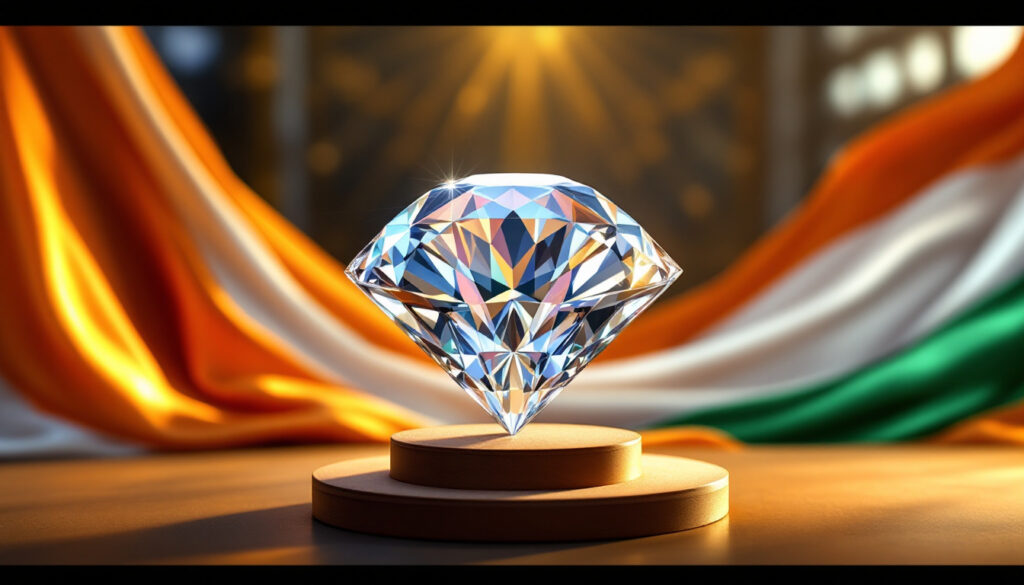India's Polished Diamond Exports Hit Two-Decade Low: A Comprehensive Analysis
India's cut and polished diamond exports have reached their lowest level in nearly two decades during the 2024/25 fiscal year, with exports falling 16.8% to $13.3 billion year-on-year, according to data from the Gems and Jewellery Export Promotion Council (GJEPC). This decline reflects broader challenges in the global diamond market, including reduced demand from key economies like the U.S. and China, geopolitical tensions, and uncertainty over U.S. tariff policies.
What Is Happening to India's Diamond Export Industry?
India's diamond export industry is facing unprecedented challenges, with polished diamond exports plummeting to levels not seen in nearly twenty years. The cut and polished diamond sector, traditionally a cornerstone of India's export economy, has experienced a dramatic downturn that reverberates throughout the gems and jewelry ecosystem.
Key Statistics on India's Diamond Export Decline
- 16.8% drop in cut and polished diamond exports to $13.3 billion
- 11.7% decrease in overall gem and jewelry exports to $28.5 billion (four-year low)
- 24.3% reduction in rough diamond imports to $10.8 billion
- 1% increase in exports during March 2025 to $2.56 billion
The marginal 1% increase in March stands out as an anomaly in an otherwise bleak landscape, primarily driven by exporters rushing shipments ahead of potential tariff implementations.
India's Position in the Global Diamond Industry
India remains the undisputed global leader in diamond processing despite the current crisis. The country processes an astounding 9 out of 10 diamonds sold worldwide, showcasing its dominant position in the value chain. Cut and polished diamonds typically account for nearly half of India's overall gem and jewelry shipments, highlighting the sector's critical importance to the country's export economy.
The diamond hubs of Surat in Gujarat and Mumbai in Maharashtra have developed specialized expertise over decades, establishing India as the world's largest cutting and polishing center. This concentration of skill and infrastructure has created a diamond processing ecosystem unmatched anywhere else globally.
Why Are Diamond Exports Declining?
The significant drop in India's diamond exports can be attributed to multiple economic and geopolitical factors affecting global demand. These challenges have created a perfect storm for India's diamond sector, with both supply and demand sides facing substantial headwinds.
Sluggish Demand from Key Markets
The United States, which serves as India's single largest diamond market, has shown decreased demand throughout 2024 and early 2025. This reduction in American purchasing power has had an outsized impact on India's export figures given the U.S. market's dominance in the global diamond trade.
Simultaneously, China—the world's second-largest diamond market—has experienced reduced diamond purchasing amid its own economic slowdown. The Chinese luxury market, once a reliable growth engine for diamond sales, has cooled considerably as domestic economic challenges persist.
These market dynamics insights are compounded by broader economic uncertainty affecting luxury purchases globally. As inflation concerns and interest rate fluctuations impact discretionary spending worldwide, diamonds—often viewed as luxury purchases—have seen diminished consumer interest.
Impact of US Tariff Announcements
Perhaps the most immediate disruptor to India's diamond exports has been the U.S. government's initial announcement of a 27% tariff on imported Indian goods. This proposed measure sent shockwaves through the industry, despite a subsequent 90-day pause declared on the tariff implementation in April 2025.
The uncertainty surrounding these tariffs has created distorted market behaviors, including a pre-tariff buying surge in March 2025. U.S. importers rushed to secure inventory before potential price increases, temporarily boosting export figures but creating an unsustainable demand pattern.
"US buyers were loading up in March before the tariffs kicked in. Indian exporters were also rushing to ship out US orders first, so they wouldn't get hit with those extra costs," explained Shaunak Parikh, vice-chairman of GJEPC, highlighting the artificial nature of the March uptick.
How Are Indian Diamond Processors Responding?
India's diamond processing sector, known for its resilience and adaptability, has implemented various strategies to weather the current crisis. These measures reflect both short-term tactical adjustments and longer-term strategic realignments.
Operational Adjustments
The most visible response has been the dramatic reduction in rough diamond imports, which fell by 24.3% to $10.8 billion. This pullback indicates processors' reluctance to maintain pre-crisis inventory levels amid uncertain demand projections. By reducing raw material purchases, Indian firms are attempting to align their production capacity with diminished global demand.
Another key adaptation has been the prioritization of U.S. shipments before potential tariff implementation. Indian exporters have reorganized their fulfillment schedules to ensure American orders receive priority, minimizing the financial impact of potential tariffs.
The industry has also embraced strategic export planning to minimize tariff impacts, including exploring alternative routes for market entry and adjusting pricing strategies to maintain competitiveness despite potential Trump's commodity policies related cost increases.
Industry Expert Insights
Shaunak Parikh, vice-chairman of GJEPC, has emphasized the tactical nature of recent export patterns: "US buyers were loading up in March before the tariffs kicked in. Indian exporters were also rushing to ship out US orders first, so they wouldn't get hit with those extra costs."
This perspective is shared by major industry players, with one prominent Mumbai-based exporter predicting exports are "unlikely to recover this year due to US tariffs roiling global markets and shaking buyer confidence," according to reports from industry sources. This pessimistic outlook reflects the deep uncertainty pervading the industry.
What Is the Outlook for India's Diamond Industry?
The diamond export industry faces continued challenges with limited signs of immediate recovery. Industry experts and global commodities insights suggest a prolonged period of adjustment before exports return to pre-crisis levels.
Short-term Projections
Market uncertainty persists due to the unresolved status of potential U.S. tariffs. The 90-day pause announced in April 2025 provides only temporary relief, with the industry bracing for possible implementation later in the year.
Consumer confidence, particularly in luxury purchases, remains fragile globally. With buyer confidence shaken by economic unpredictability, discretionary spending on items like diamonds faces continued headwinds.
Most industry analysts anticipate limited recovery in the 2025/26 fiscal year, with exports likely to remain below historical averages until market conditions stabilize more broadly.
Factors to Watch
Several key indicators will determine the trajectory of India's diamond export recovery:
The implementation timeline for U.S. tariffs remains the most immediate concern. Any resolution or extension of the current pause would significantly impact export projections.
Economic recovery patterns in key markets, particularly the United States and China, will directly influence demand for Indian diamonds. Consumer confidence metrics and luxury goods spending in these markets serve as critical leading indicators.
Global luxury goods purchasing trends, including potential shifts in consumer preferences toward other luxury categories, could reshape demand for diamonds over the medium term.
The development of alternative markets beyond traditional strongholds presents a potential bright spot. Markets in Southeast Asia and the Middle East may offer growth opportunities that could partially offset declines in established markets.
FAQ About India's Diamond Export Crisis
How significant is the diamond industry to India's economy?
The gems and jewelry sector represents one of India's most crucial export categories, with diamond cutting and polishing being the cornerstone of this industry. The sector typically generates over $15 billion in annual exports, making it a vital contributor to India's foreign exchange earnings.
Beyond direct export value, the industry supports extensive domestic supply chains and auxiliary businesses, creating a multiplier effect throughout local economies. The sector's significance extends beyond financial metrics to include substantial employment generation and skill development.
How does the current export level compare historically?
The current $13.3 billion export figure represents the lowest level in nearly two decades, highlighting the severity of the current downturn. This figure marks a steep departure from the sector's peak performance years when exports exceeded $20 billion annually.
The magnitude of this decline is particularly concerning given the industry's previous resilience through various global economic cycles. Unlike temporary dips experienced during earlier downturns, the current crisis appears more structural in nature, with multiple factors converging to create unprecedented challenges.
What impact might this have on employment in India's diamond sector?
India's diamond industry directly employs millions of workers, with cutting and polishing centers in Gujarat and Maharashtra serving as major employment hubs. The current downturn has already led to reduced working hours and temporary layoffs in many facilities.
The employment impact extends beyond direct workers to include support services, logistics providers, and retail operations dependent on the diamond trade. Small-scale artisans and workers in informal settings are particularly vulnerable to industry contractions, often lacking financial buffers or alternative employment options.
If the export slump continues, more permanent workforce reductions may become inevitable, potentially triggering broader socioeconomic challenges in regions heavily dependent on diamond processing.
Are other diamond processing countries experiencing similar declines?
While India's dominant position (processing 90% of global diamonds) means global market issues affect it disproportionately, other diamond processing centers are experiencing similar challenges. However, India's scale of operations makes its downturn particularly significant for global diamond supply chains.
Smaller processing hubs in Belgium, Israel, and emerging centers in Africa have reported comparable demand challenges, suggesting this is indeed a global market issue rather than an India-specific competitive disadvantage. However, India's lower cost structure may provide some comparative advantage during the recovery phase once demand stabilizes.
Adapting to the New Diamond Market Reality
India's diamond industry stands at a crossroads, facing unprecedented challenges but possessing significant structural advantages that could facilitate eventual recovery. The sector's demonstrated adaptability, deep expertise, and established infrastructure position it to rebound once global market conditions improve.
Diversification Strategies
Forward-thinking companies are exploring product diversification beyond traditional diamond categories. This includes greater emphasis on lab-grown diamonds, which offer more stable supply chains and potentially higher margins.
Geographic market diversification represents another promising avenue, with increasing focus on developing markets in Southeast Asia, Eastern Europe, and parts of Latin America to reduce dependency on the U.S. and China.
Technological Innovations
The current crisis has accelerated digital transformation within the industry. Advanced cutting technologies, AI-powered design tools, and improved inventory management systems are being deployed to enhance efficiency and reduce operational costs.
E-commerce platforms and virtual showcasing technologies enable Indian exporters to reach buyers without traditional travel and trade show expenses, potentially opening new market segments previously difficult to access.
The road to recovery will require patience, innovation, and strategic adaptation from all industry stakeholders. While near-term challenges persist, India's central position in global diamond processing ensures its continued relevance in the evolving gold market analysis and broader investment market insights within the precious metals and gems sector.
Ready to Capitalise on the Next Major Market Opportunity?
Stay ahead of significant market developments with Discovery Alert's proprietary Discovery IQ model, which delivers real-time notifications on ASX mineral discoveries across multiple commodities including precious metals. Explore historic returns from major discoveries by visiting our dedicated discoveries page and position yourself for potential market-beating returns.




